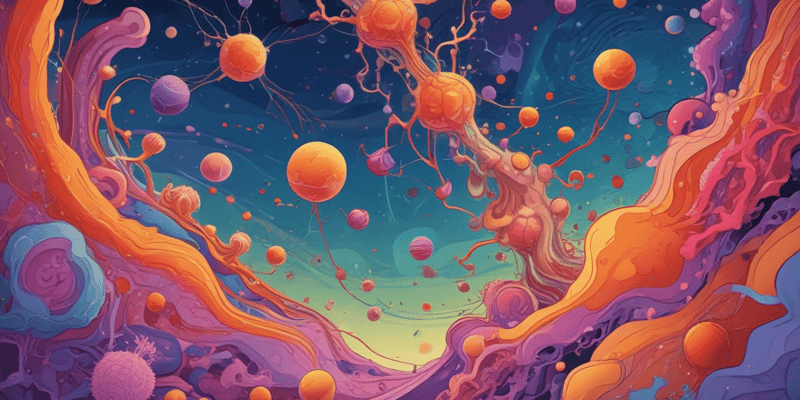Questions and Answers
What is the primary function of IL-2 in terms of cytokine-receptor interactions?
T-cell activation
What is a characteristic of cytokines in terms of their production?
They require a stimulus for production
Which type of cytokine binding results in the activation of cells in the immediate vicinity?
Paracrine binding
Which of the following cytokine families includes IL-2 and IL-4?
Signup and view all the answers
What is the primary source of cytokines?
Signup and view all the answers
What is a function of cytokines secreted by TH cells?
Signup and view all the answers
What is the primary characteristic of acute phase of inflammation?
Signup and view all the answers
Which type of cytokine promotes systemic inflammation?
Signup and view all the answers
What is the primary function of anti-inflammatory cytokines?
Signup and view all the answers
What is the role of cytokines in host responses?
Signup and view all the answers
What is the effect of proinflammatory cytokines on disease?
Signup and view all the answers
What is the primary difference between proinflammatory and anti-inflammatory cytokines?
Signup and view all the answers
What is a common feature among the receptors for IL-2, IL-4, and IL-7?
Signup and view all the answers
What is the consequence of cytokine binding to its receptor?
Signup and view all the answers
What type of immunity is activated by Th1 cells?
Signup and view all the answers
Which of the following cytokines is not typically produced by Th2 cells?
Signup and view all the answers
What is the primary target of the cytokine IL-7?
Signup and view all the answers
What type of cytokine is IL-10?
Signup and view all the answers
What is the role of JAKs in cytokine signaling?
Signup and view all the answers
What is the effect of bacterial cell wall endotoxins on macrophages?
Signup and view all the answers
What is the role of Th2 cells in immune responses?
Signup and view all the answers
Which cytokine is a chemokine that primarily targets neutrophils and endothelial cells?
Signup and view all the answers
What is the consequence of a defective γ chain in X-linked severe combined immunodeficiency disease (SCID)?
Signup and view all the answers
What type of bacteria can cause bacterial septic shock?
Signup and view all the answers
What is the result of phosphorylation of STATs by JAKs?
Signup and view all the answers
What is a common symptom of bacterial septic shock?
Signup and view all the answers
What is the primary mechanism by which bacterial septic shock develops?
Signup and view all the answers
What is one of the roles of cytokines in immune responses?
Signup and view all the answers
What is a potential therapeutic strategy for treating bacterial septic shock?
Signup and view all the answers
Study Notes
Cytokines
- Cytokines are soluble messenger molecules, which are low molecular weight proteins secreted by various cells, playing a crucial role in the induction and regulation of immune responses.
- They can activate many cells, but their production requires a stimulus, and they bind to specific receptors with high affinity, inducing gene activation.
Cytokine Receptor Interactions
- Cytokines can bind receptors and alter gene expression.
- There are three primary functions of cytokine-receptor interactions:
- Autocrine: affects the secreting cell (self).
- Paracrine: affects cells in the immediate vicinity, binding another cell close by.
- Endocrine: affects cells remote from the secreting cell.
Categories of Cytokines
- There are four structural families of cytokines:
- Hematopoietin family (IL-2, IL-4).
- Interferon family.
- Chemokine family.
- Tumor Necrosis Factor (TNF) Family.
Cells That Make Cytokines
- A variety of cells can produce cytokines, but the primary sources are T helper (TH) cells and macrophages (MΦ).
- Cytokines secreted by TH cells can affect B cells, cytotoxic T cells (CTLs), MΦ, and natural killer (NK) cells.
- Cytokines are involved in hematopoiesis, adaptive immunity, innate immunity, and inflammation.
Inflammation and Cytokines
- Inflammation is characterized by increased blood flow and vascular permeability, along with the accumulation of fluid, leukocytes, and inflammatory mediators like cytokines.
- Inflammatory cytokines can be divided into two groups:
- Those involved in acute inflammation.
- Those responsible for chronic inflammation.
- Proinflammatory cytokines promote systemic inflammation, while anti-inflammatory cytokines reduce inflammation and promote healing.
Functions of Cytokines
- Various cytokines have different functions, including:
- IL-2: activates T cells and macrophages.
- IL-4: involved in hematopoiesis and activates TH2 cells and B cells.
- IL-6: induces acute-phase proteins and activates TH2 cells and B cells.
- IL-7: involved in hematopoiesis.
- IFN-γ: activates macrophages and induces the production of reactive oxygen species.
CD4+ T Helper Subsets
- CD4+ T helper cells can be divided into subsets based on their cytokine production:
- TH1 cells produce IL-2, IFN-γ, and TNF-β, activating cell-mediated immunity.
- TH2 cells produce IL-4, IL-6, and IL-10, activating humoral immunity.
Receptor Signaling
- Most cytokine receptors are not expressed in high numbers in completely resting cells but are upregulated after cell activation.
- Ligand binding causes the aggregation of receptors at the cell surface, leading to the phosphorylation of JAKs and STATs, and eventually, gene expression.
Roles of Cytokines in Immune Responses
- Cytokines play key roles in:
- Initiating inflammation.
- T-cell priming.
- The development of T-cell specialization.
- The winding down of the immune response.
Studying That Suits You
Use AI to generate personalized quizzes and flashcards to suit your learning preferences.
Description
Understand the functions of cytokines, including their binding to receptors, altering gene expression, and three primary functions. Learn about autocrine, paracrine, and endocrine interactions, and their role in T-cell activation and inflammation.




